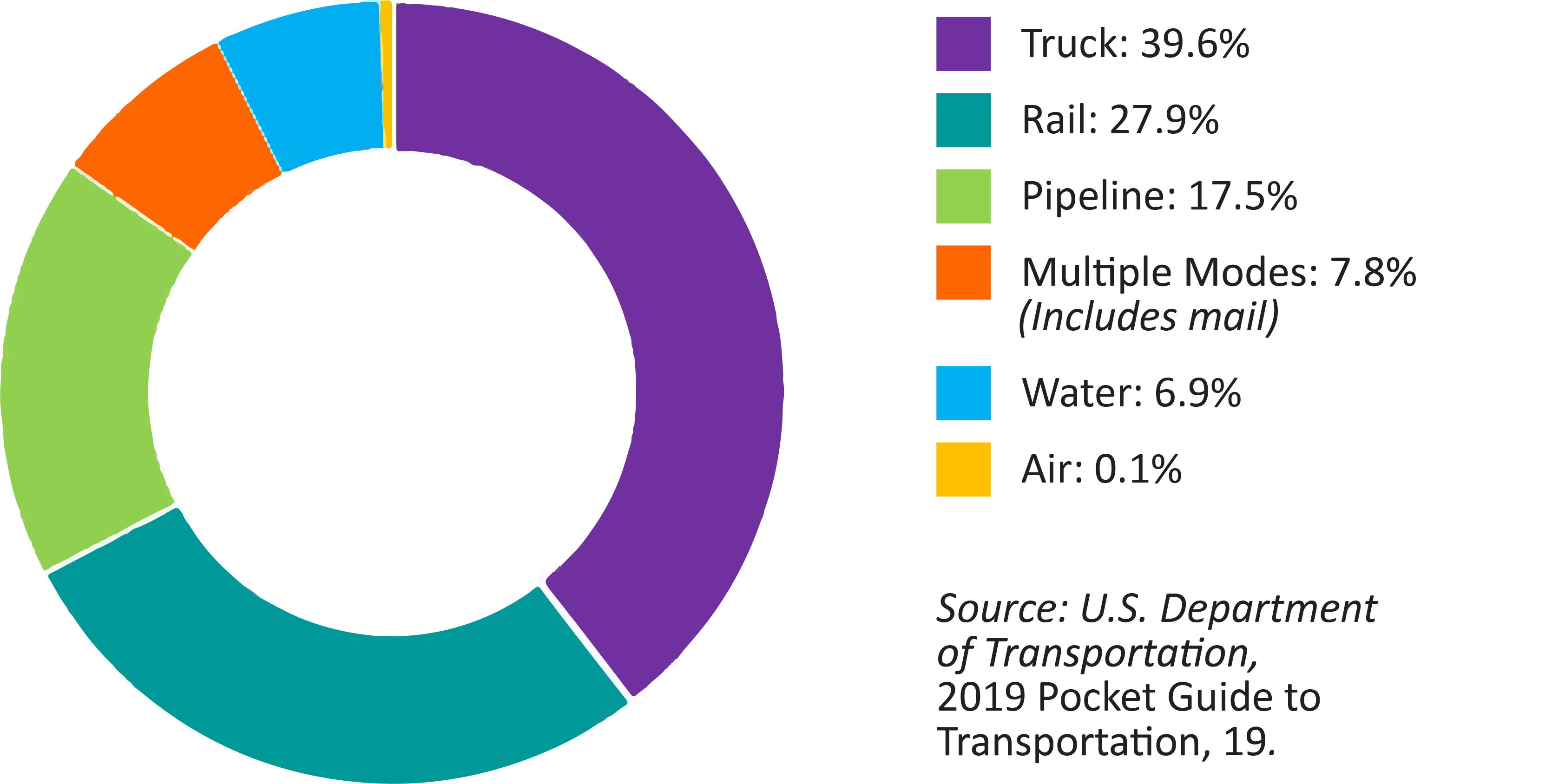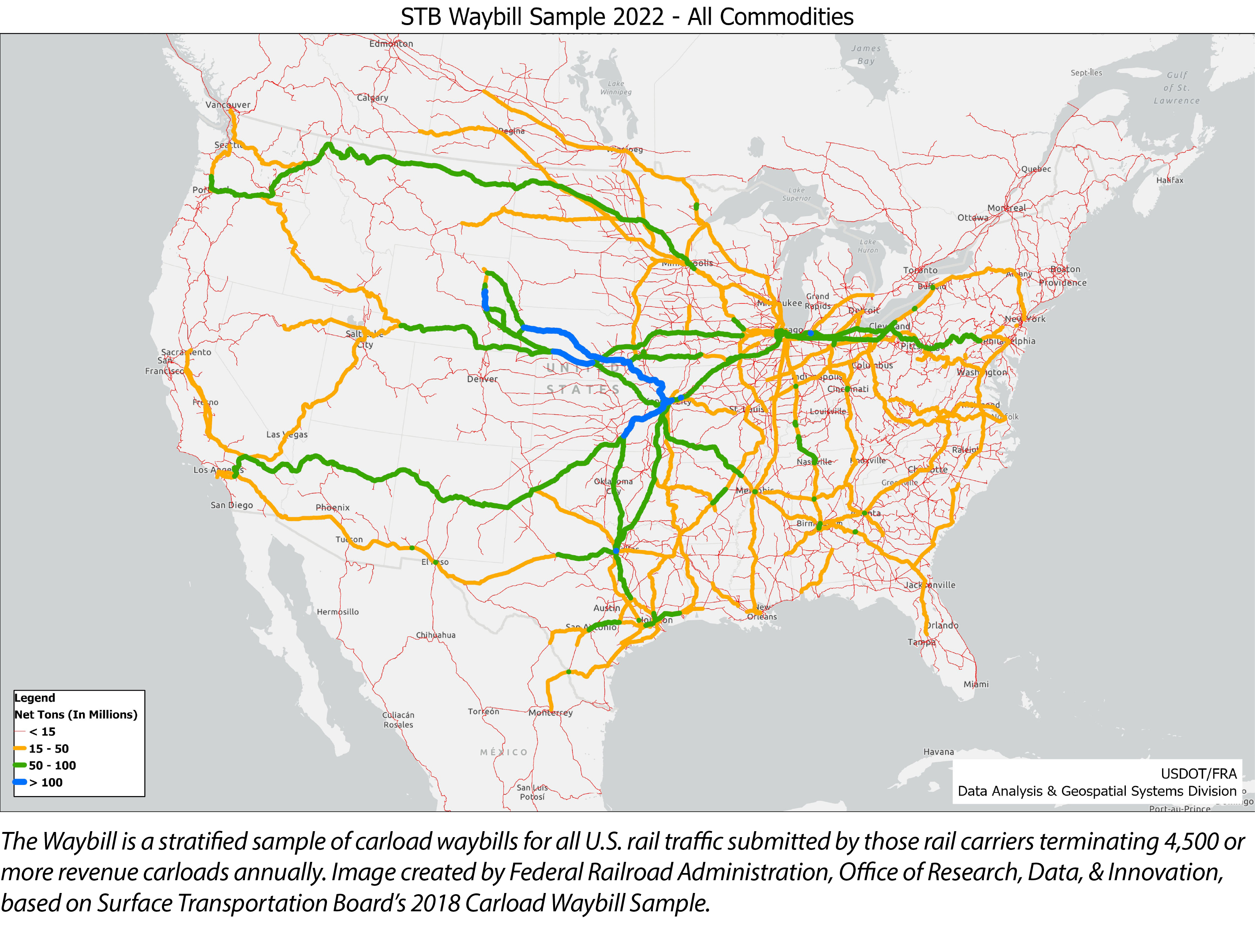Freight Rail Overview

The Freight Rail Network
Running on almost 140,000 route miles, the U.S. freight rail network is widely considered the largest, safest, and most cost-efficient freight system in the world. [1] The nearly $80-billion freight rail industry is operated by seven Class I railroads [2] (railroads with operating revenues of $490 million or more) [3] and 22 regional and 584 local/short line railroads. [4] It provides more than 167,000 jobs [5] across the United States and offers ancillary benefits that other modes of transportation cannot, including reductions in road congestion, highway fatalities, fuel consumption, greenhouse gases, cost of logistics, and public infrastructure maintenance costs.
Unlike roadways, U.S. freight railroads are owned by private organizations who are responsible for their own maintenance and improvement projects. Compared with other major modes of transportation, railroad owners invest one of the highest percentages of revenues (19 percent) to maintain and add capacity to their system, spending nearly $25 billion annually. [6]
[1] See Railway Technology, “The world’s 10 longest railway networks,” February 2014; Association of American Railroads, “Overview of America’s Freight Railroads,” March 2020.
[2] The seven Class I freight railroads are: BNSF Railway Co., Canadian National Railway (Grand Trunk Corporation), Canadian Pacific (Soo Line Corporation), CSX Transportation, Kansas City Southern Railway Co., Norfolk Southern Combined Railroad Subsidiaries, and Union Pacific Railroad Co. The combined revenue of Class I railroads equaled $67 billion in 2017.
[3] Association of American Railroads, “Overview of America’s Freight Railroads,” March 2020.
[4] Association of American Railroads, Railroad Facts, 2019 Edition, 3.
[5] Railroad Facts, 2019 Edition, 3.
[6] Association of American Railroads, “Freight Railroad Capacity and Investment,” March 2020.
Freight is moved by rail, waterways, pipeline, truck, and air throughout the United States.  Rail has an advantage in moving heavy freight over long distances efficiently, as do waterways and pipeline services. Trucks provide time-sensitive delivery services for more high-value goods being transported over medium- and short-haul distances.
Rail has an advantage in moving heavy freight over long distances efficiently, as do waterways and pipeline services. Trucks provide time-sensitive delivery services for more high-value goods being transported over medium- and short-haul distances.
Heavy freight such as coal, lumber, ore, and heavy freight going long distances are likely to travel by rail, or some combination of truck, rail, and water. The rail network accounted for approximately 28 percent of U.S. freight movement by ton-miles (the length and weight freight travels). [7] The Waybill Sample map shows U.S. rail routes by tonnage of commodities they carry.
[7] U.S. Department of Transportation, 2019 Pocket Guide to Transportation, 19.

Rail is a cost-effective and efficient way to move almost any freight in the United States, which benefits both producers and consumers. Each American requires the movement of approximately 54 tons of freight per year. Goods people use or components of the goods people use are largely shipped by rail. [8]

In all, 52 percent of rail freight car loads consist of bulk commodities such as agriculture and energy products, automobiles and components, construction materials, chemicals, equipment, food, metals, minerals, paper, and pulp. The remaining 48 percent is intermodal traffic that generally consists of consumer goods and other miscellaneous products. [9] Intermodal traffic is made up of shipping containers of all types of goods that can be transferred easily from rail to truck, plane, or other vessel, and vice versa.
U.S. rail freight moves on a variety of cars, depending on the goods being transported—from refrigerated cars for shipping perishables to flatbed cars for aircraft or automobile parts to intermodal shipping containers. Modern freight trains average roughly 73 cars (but top train length is 200 cars and growing), whereas the average freight train length in 1929 was 48 cars. [10]
Goods in the United States move predominantly to and from ports, manufacturing hubs, and areas of specific economic activity, from rural areas for agriculture and energy products to population centers or outlying regions where power plants and large manufacturing facilities are located.
Freight rail participates in achieving national export goals and facilitating the safe and efficient importation of goods via both the East and West Coasts and to and from Mexico and Canada. (See U.S. Rail-Carried Trade with Canada and Mexico for additional information on the volumes and values of commodities that flow between North American countries and the most important freight gateways along the borders.)
[8] Association of American Railroads, “Freight Rail: Making Modern Life Possible for Consumers,” March 2018.
[9] Association of American Railroads, Railroad Facts, 2019 Edition, 27 (Class 1 railroads only).
[10] Association of American Railroads, Railroad Facts, 2019 Edition, 38.
Because of technological advancement and innovation, rail continues to be unrivaled by other modes for fuel efficiency. Trains are four times more efficient than trucks, moving one ton of freight 470 miles on just a single gallon of diesel fuel. [11] Rail’s lower fuel consumption also leads to lower carbon emissions overall. Despite handling a third of all intercity freight volume, rail accounts for 2.0% of all transportation-related emissions. [12]
[11] Association of American Railroads, “Freight Railroads Embrace Sustainability & Environmental Preservation," February 2019.
[12] Environmental Protection Agency, “Fast Facts: U.S. Transportation Sector Greenhouse Gas Emissions 1990–2017,” June 2019, 1.
Population and demographic trends pose an enormous challenge for U.S. transportation infrastructure and operators. Forecasts suggest that the United States is becoming more urbanized, and urbanized areas will increasingly converge into larger metropolitan networks (called megaregions) as the population continues to grow. As a result, these regions will demand a higher volume of freight, which means greater traffic congestion, increased emissions, more frequent infrastructure maintenance, and loss of economic productivity.
Freight railroads in the United States are poised to meet increased freight demands by offering innovative transportation solutions, such as intermodal transportation with double-stacked containers on railcars. With future population and economic growth, and the subsequent growth in freight, experts anticipate that railroads will continue to make the necessary investments in the capacity required to move heavy and long-distance shipments. [13]
[13] American Association of Railroads, “Freight Railroad Capacity and Investment,” March 2020.
